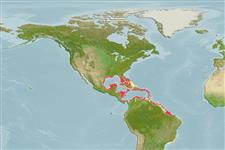Common names from other countries
>
Syngnathiformes (Pipefishes and seahorses) >
Syngnathidae (Pipefishes and seahorses) > Syngnathinae
Etymology: Hippocampus: Greek, ippos = horse + Greek,kampe = curvature (Ref. 45335).
More on author: Ginsburg.
Environment: milieu / climate zone / depth range / distribution range
экология
морской; солоноватоводный ассоциированный с рифами; немигрирующий; пределы глубины 0 - 60 m (Ref. 30915). Subtropical; 29°N - 25°S, 133°W - 40°W (Ref. 57010)
Western Atlantic: USA (North Carolina) to Brazil; the Caribbean Sea.
Length at first maturity / Size / Вес / Возраст
Maturity: Lm 8.0 range ? - ? cm
Max length : 17.5 cm OT самец/пол неопределен; (Ref. 30915)
колючие лучи спинного плавника (общее число) : 0; членистые (мягкие) лучи спинного плавника (общее число) : 16 - 19.
Uncommon in most areas, but may be locally common in certain places. Usually attached to gorgonians or seagrasses but may occur in floating Sargassum or swimming freely in midwater (Ref. 9710). Ovoviviparous (Ref. 205). The male carries the eggs in a brood pouch which is found under the tail (Ref. 205). Has been reared in captivity (Ref. 35409). Length type refers to Height (= from top of coronet to the tip of straightened tail). Maximum depth reported taken from Ref. 128812.
Breeding season more than 8 months in laboratory; egg diameter 1.2 mm; gestation period 2 weeks, depending on water temperature; young approximately 7 mm at birth; pair-bonded in wild (Ref. 30915). Monogamous mating is observed as both obligate and genetic (Ref. 52884).
Lourie, S.A., R.A. Pollom and S.J. Foster, 2016. A global revision of the seahorses Hippocampus Rafinesque 1810 (Actinopterygii: Syngnathiformes): taxonomy and biogeography with recommendations for further research. Zootaxa 4146(1):1-66. (Ref. 115213)
Статус Красного Списка МСОП (Ref. 130435)
Угроза для людей
Harmless
Использование человеком
рыболовство: не имеет хозяйственного значения
дополнительная информация
инструменты
Специальные отчеты
Скачать в формате XML
ресурсы в Интернет
Estimates based on models
Preferred temperature (Ref.
115969): 24 - 28, mean 26.7 (based on 164 cells).
Phylogenetic diversity index (Ref.
82804): PD
50 = 0.5000 [Uniqueness, from 0.5 = low to 2.0 = high].
Bayesian length-weight: a=0.00447 (0.00177 - 0.01127), b=3.00 (2.78 - 3.22), in cm Total Length, based on LWR estimates for this (Sub)family-body shape (Ref.
93245).
Trophic level (Ref.
69278): 3.4 ±0.5 se; based on size and trophs of closest relatives
устойчивость к внешним воздействиям (Ref.
120179): средний (среднего размера), минимальное время удвоения популяции 1.4-4.4 года (Assuming annual Fec<1000).
Fishing Vulnerability (Ref.
59153): Low vulnerability (12 of 100).
